Having your data backed up and saved in a safe location is always a smart thing to do. It provides data redundancy and the data be restored if something bad were to happen to the original device.
This is why Windows 10 offers multiple ways to backup data on your device in such a way that it can be used later in case you are not able to boot your device, or your hard drive goes astray.
Table of Contents
This is also the reason we have cloud backup utilities and other third-party software to do that for us, such as OneDrive. However, uploading large files to the Cloud over the internet is a big process and consumes a lot of internet data as well.
In this article, we discuss the benefits of the backup features that come built into Windows 10 and how they can be used with utmost optimization.
Backing up your critical data
Microsoft understands the needs of its users and has provided several ways to create various types of system backup utilities, each with a different use. Even though these features save users from losing their data from unanticipated system failures, many are still not using these features on their Windows 10 systems.
As these utilities come built into Windows 10, it hints that it is not only limited to IT Administrators or corporate individuals but for every type of user running the Operating System.
Let’s continue to see what these features are, how to set them up, and how they can be beneficial for the users.
File History
File History is a Windows 10 feature that lets its users back up their personal files and folders onto an external or remote device. This feature was launched in Windows 8 and is now a part of Windows 10.
File history needs to be set up only once to automate data backup at regular time intervals. The uniqueness of this feature is not that it takes regular backups, but the fact that it retains older versions of the files and folders as well, in case the user wishes to revert to them.
Only those duplicate files are saved to whom the user has made any changes to. Hence, a new backup of your system will only take up additional space of the files that have been modified, while keeping the storage space of the others unaffected.
A setback for this feature is that the files are kept in their original size. Hence, the backups may take up a large portion of space on the backup device, depending upon the size of each backup and the time it is retained for. The backup destination device could be an external hard drive or a remote location over the local network or the Internet.
How to set up File History in Windows 10
- To set up File History, navigate to the following:
Start Menu -> Settings -> Update & Security -> Backup - Under Backup using file history click Add a drive.
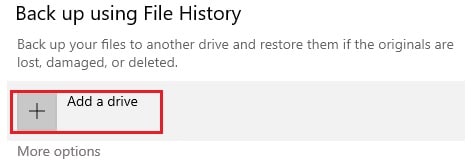
- In the small popup window, select an external drive to save the data backup. This can be changed to over a network later.

Selecting a drive will automatically start the backup of the files and folders that are selected by default. - If you wish to modify the settings to your liking, click on More options. Click on the slider to stop the automatic backup of files at any time.
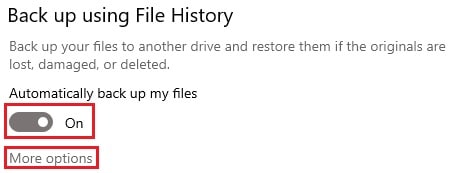
- In the Backup options window, you can click Back up now to begin backing up your data.
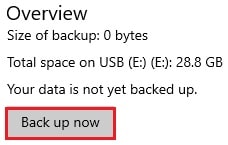
The files and folders are then backed up to the destination device under a folder named FileHistory. - In the Backup options window, you can choose when to take a backup of the selected files with a range from 10 minutes to once daily. You can also choose the time to keep the backed up data from a range of 1 month to 2 years, or even forever.
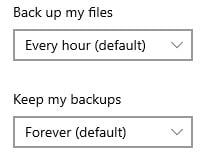
- Below Backup these folders, you can add more folders to backup by clicking Add, or remove the existing folders by clicking on them, and then click Remove.
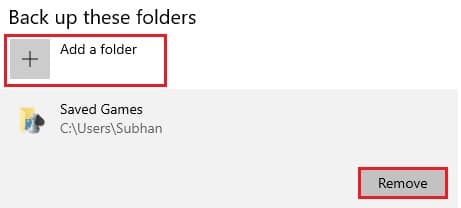
- You may also add folders to exclude from backup under Exclude these folders.
Manage File History on Windows 10
If at any point you wish to change the location of the data being backed up, click on stop using drive under Backup to a different drive. Note that this will clear all settings, a new device will need to be added again, and all configurations will be reset to default.
However, if you wish to change the location of the backup to a device over the network, click on See advanced settings at the very bottom.
In the new window, click on Select drive on the left, and then click on Add network location. Now enter the path of the new device over the network or map a network drive through the File Explorer and then select it.
How to restore using File History
Once your data is fully backed up for the first time, it will now be visible under restore files from a current backup in the Backup options window. You can select the files and folders to restore, and click on the green icon at the bottom.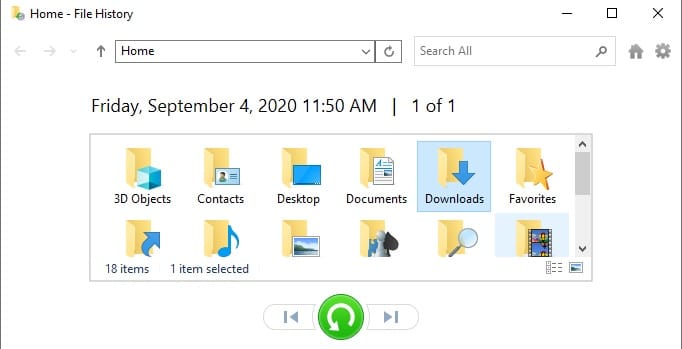
You can also jump between the different versions of the same file/folder if they are still available at the backup location by clicking the buttons on the sides of the green recovery button.
If a similar file or folder name still exists at the source location, you will be prompted whether to replace the file or to skip it.
You can also directly convert a file to its older state, provided the backup drive is accessible to the system. Here is how to do this:
- Right-click on the file and click on Properties from the context menu.
- Go to the Previous Versions tab and select the version you wish to restore.
You can also change the location of the file to be restored, or open it to view its contents before restoring.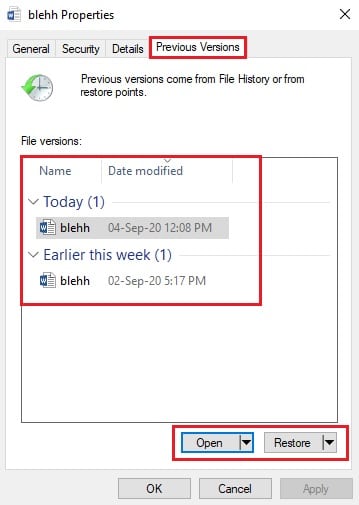
If you wish to clear up space on the backup destination drive, you can easily delete the files directly by using File Explorer. Note that they will no longer be available to restore from.
Backup and Restore (Windows 7)
The Backup and Restore (Windows 7) utility is another way to store your data on an external, or internal storage for redundancy. You would notice that the feature is suffixed with the words Windows 7. This is because users can utilize this feature to restore their data from a host running Windows 7 to a new device running Windows 10.
The feature was also available on Windows 8, but removed from Windows 8.1 where File History was the only backup and restore feature available. This feature was then again introduced in Windows 10 to give its users the benefit of maximum options and support.
Unlike File History, Backup and Restore does not have the characteristic of retaining the previous version of the files. However, it does offer its user to create complete image backups. This means that all the data as well as the system files are backed up into an ISO image, which can be kept both locally or extracted into a USB for booting.
A downside to this awesome feature is that it takes a significant amount of time to create the snapshot image. Moreover, since you are backing up everything, the backup will require more space than the files themselves.
This feature is also helpful for those who need to deploy Windows installations on multiple devices using standard applications and settings. They can create one environment, take its snapshot, and use the new image to deploy on every other computer. This is, of course, if you do not already have Windows Deployment Services.
How to set up Backup & Restore on Windows 10
Here’s how you can set up Backup & Restore on Windows 10:
- To set up Backup and Restore on your Windows 10, navigate to the following:
Start Menu -> Settings -> Update & Security -> Backup - Click on Go to Backup and Restore (Windows 7) at the bottom of the page.

- The new window will launch in Control Panel. Under the Backup heading, click on Set up backup.
- In the new window, select the location where you wish to save your backup data. It can be a partition on the local hard drive (except the system partition) or can be on an external hard drive, provided there is enough space. You may also click Save on a network if you wish to create a backup on the device over the network. Click Next when you have selected.
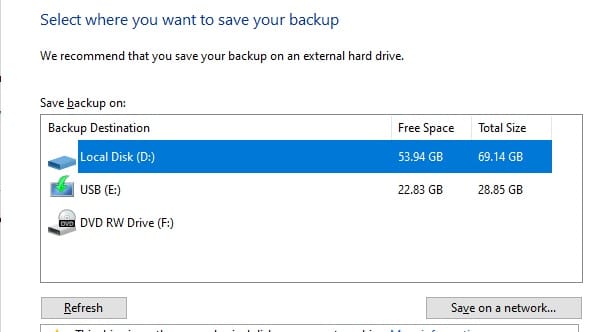
- On the What do you want to backup window, select Let Windows choose if you want to keep the settings as default, or select Let me choose to set the settings manually. Click Next when selected.
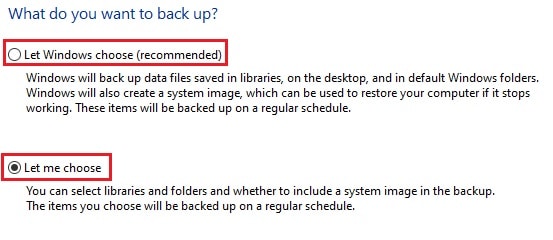
- If you have selected Let me choose, then in the next window, you will need to select what you wish to backup. You can also choose to create a system image or not. You may expand each section to customize further. Then click Next.
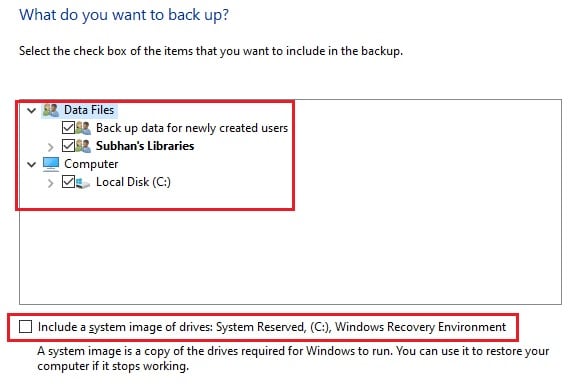
- On the Review your backup settings page, you can customize the schedule of the routine backup to be performed by clicking Change schedule.
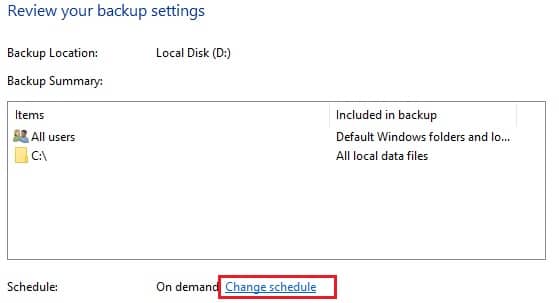
- If you click Change schedule, you can now customize the day and timing of regular system backups by checking the box next to Run backup on a schedule and then adjusting the drop-down menu below it.
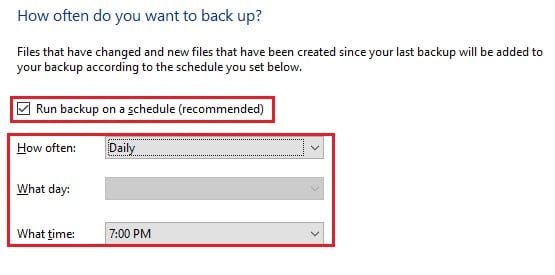
- Click Ok and then save settings and exit.
You have now successfully setup an automatic system backup.
You may also only create a system image backup of your device manually by clicking Create a system image on the left of the Backup and Restore (Windows 7) window.
Note that these backups are retained for as long as the user wants and does not delete them. However, the old backups are automatically replaced when a new backup is taken.
How to manage Backup & Restore in Windows 10
If at any point you wish to stop this backup, simply navigate to Backup and Restore (Windows 8) in the Control Panel, and click on Turn off schedule on the left. You may also view the current backups or view available space by clicking on Manage space, or change the backup settings by clicking Change settings.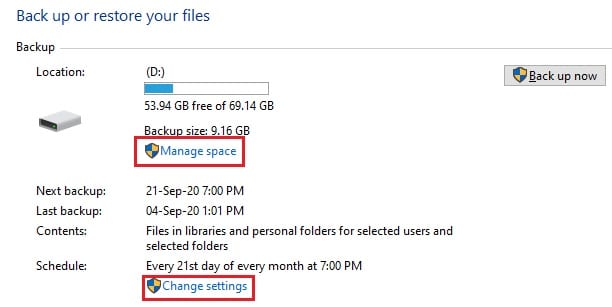
If you click Manage space, you can delete existing backups by clicking on View backups, selecting the backup from the list, and then click Delete next to it.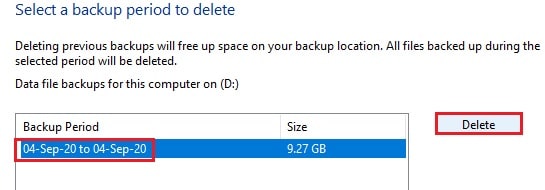
Alternatively, it can also be deleted through File Explorer.
Backup and Restore do not keep older versions of the files and folders, but it can be set to keep older versions of the complete system images. This can be done by going to the Manage space window and then clicking Change settings under System image. If it is grayed out, it means that you currently do not have an image. Now select one of the two options:
- Let Windows manage the space used for backup history
- Keep only the latest system image and minimize space used by backup
Selecting the second option will only retain the latest image files and replace the old one. By selecting the first option, the system will retain all previous files as well as create new system images, but only until the backups take less than 30 percent of the overall partition. If the backup images go beyond 30 percent, it will start deleting older images to make room for a new one.
How to restore using Backup & Restore (Windows 7) in Windows 10
Once a backup is available, whether new or created from an old system running Windows 7, you can restore it to a computer running Windows 10 by clicking Restore under the Restore section, and then browse to the location of the restoration file. You may add multiple files and folders to restore at the same time.
Alternatively, you can navigate to the backup files through File Explorer and double-click, then select one of the actions listed below: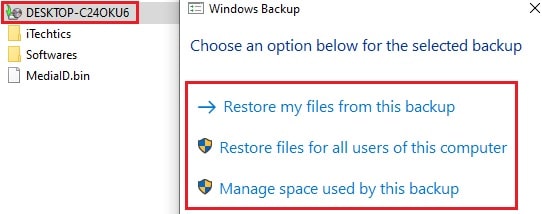
In the event your computer fails to boot, you can use an external bootable drive with the latest ISO image of your backup to reinstall the OS. The backup ISO already contains all the settings and configuration files, as well as your personal data to create an environment that is the same as the one before. Here is a guide on how to create and use external bootable drives.
You can also revert your OS to a previous version from a backup on your internal storage by performing the following:
- Navigate to:
Start Menu -> Settings -> Update & Security -> Recovery -> Restart now - Your computer will now reboot. Click on Troubleshoot, and then on System image recovery.
- Then select Use the latest available system image, then click Next.
- Check the box next to Format repartition disks and then click Next. Note that if you wish to save any data on other disks, click on Exclude disks and select the ones you do not wish to format.
- Now navigate through the wizard to the end for the image to be installed.
Closing words
Both File History and Backup & Restore (Windows 7) are useful tools, especially for those users who have critical data on their local computer and cannot afford to lose it. It is up to the users to choose which of the methods they prefer or use both simultaneously.
File History is designed for people who prefer saving their personal files and folders and can reinstall a fresh OS when required. Users that frequently change their files and often need to undo their changes can resort to this solution as well.
Users who require their system configuration to remain intact and do not afford to lose their entire operating system, or the people using old hardware that can crash at any moment can resort to using the Backup & Restore (Windows 7) feature. As mentioned earlier, a user can also prepare a computer with the basic configurations and applications and then use its snapshot to mirror on other computers, saving time and resources.
